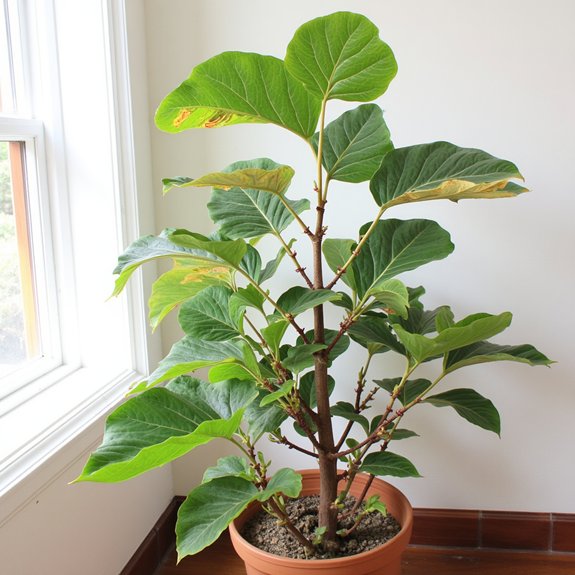Fiddle leaf figs develop drooping leaves for specific, identifiable reasons that plant owners can address with targeted solutions. The most common culprits include watering inconsistencies, environmental stress, and recent repotting trauma that disrupts root systems. Each cause produces distinct symptoms, from yellowing edges to sudden wilting, making proper diagnosis essential for effective treatment. Understanding these warning signs helps gardeners determine whether their plant needs immediate intervention or simply time to recover from recent changes.
Contents
Common Causes of Drooping Leaves in Fiddle Leaf Figs

When fiddle leaf fig owners notice their plant’s leaves beginning to droop, several underlying factors could be responsible for this concerning change. Overwatering issues top the list, as soggy soil suffocates roots and prevents proper nutrient absorption. Conversely, underwatering creates drought stress that causes leaves to wilt downward.
Temperature fluctuations shock the plant’s system, while inadequate humidity levels below 40-50% stress the foliage. Recent repotting disturbs root systems, creating transplant shock that manifests as drooping within days. Poor drainage compounds these problems by creating waterlogged conditions that damage delicate root structures and compromise the plant’s overall stability.
How Repotting Stress Affects Your Plant
Among the various factors that trigger drooping leaves, repotting stands out as one of the most predictable stressors for fiddle leaf figs. The process inevitably causes root disturbance, disrupting the delicate network that supplies water and nutrients to leaves.
When roots get jostled during transplanting, they temporarily lose efficiency in moisture uptake. Changes in soil composition further complicate recovery, as different drainage rates affect hydration patterns. New potting mix may retain more or less water than before, confusing the plant’s established rhythms.
This transplant shock typically manifests within 24-48 hours, with leaves drooping as the plant redirects energy toward root repair and adaptation.
Essential Care Steps After Repotting

Stabilizing the care routine becomes critical once transplant shock sets in, as hasty adjustments can worsen drooping symptoms. Soil selection matters tremendously here—well-draining potting mix prevents waterlogged roots while retaining adequate moisture. Check soil dampness two inches down before watering, establishing consistent watering frequency based on actual need rather than calendar dates.
Keep the plant in bright, indirect light without relocating it frequently. Maintain temperatures between 65-75°F and humidity around 40-50%. Resist fertilizing for 4-6 weeks, allowing energy to focus on root establishment. Monitor leaf recovery weekly, expecting gradual improvement over several weeks as the fiddle leaf fig adapts.
Environmental Adjustments for Optimal Recovery
Beyond consistent daily care, the surrounding environment requires fine-tuning to support a drooping fiddle leaf fig’s recovery process. Humidity levels should remain between 40-60% to prevent additional stress on already compromised leaves. Place a humidity tray beneath the pot or group plants together to naturally increase moisture. Temperature stability proves equally critical during recovery, maintaining 65-75°F consistently. Avoid placing the plant near heating vents, air conditioners, or drafty windows that create fluctuations. Light exposure should remain unchanged from pre-repotting conditions. Sudden environmental shifts can prolong drooping symptoms, while stable conditions encourage faster leaf recovery and stronger root establishment.
What to Expect During the Healing Process

Most fiddle leaf fig owners notice the first signs of recovery within 7-14 days after repotting, though complete healing typically spans 4-6 weeks. During this period, drooping leaves gradually regain their upright position as the root system establishes in fresh soil.
Patience needed here is vital, as rushing the process often backfires. New growth may pause temporarily while the plant focuses energy on root development. Leaf recovery progresses slowly but steadily, with older leaves potentially remaining slightly less perky than new ones. Monitor daily changes, but resist the urge to constantly adjust care routines during this delicate healing phase.
